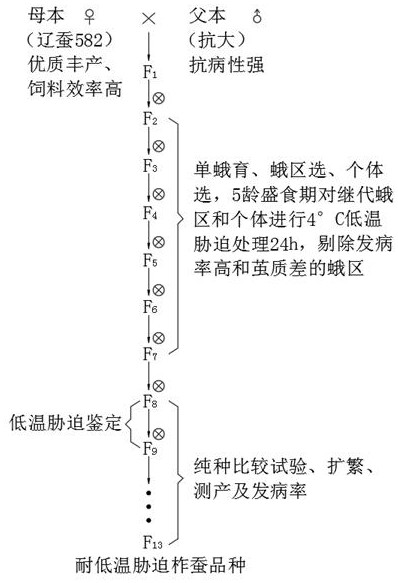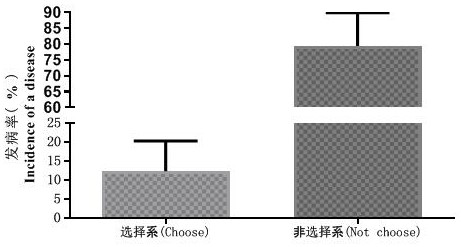Antheraea pernyi larva low-temperature stress induced resistance breeding method
A technology of low temperature stress and resistance, applied in animal husbandry and other fields, can solve the serious problems of tussah silkworm disease, achieve high reliability and pertinence, ensure high yield, and ensure stability
- Summary
- Abstract
- Description
- Claims
- Application Information
AI Technical Summary
Problems solved by technology
Method used
Image
Examples
Embodiment 1
[0028] The tussah silkworm variety Liaocan 582 with high yield, high quality and high feed efficiency was selected as the female parent, and the tussah silkworm variety Kangda with strong disease resistance was selected as the male parent for hybridization to obtain F 1 Generation, F 1 After generation selfing, F 2 -F 7In the segregation population, the moth plots and individuals were selected, and the moth plots were subjected to low temperature stress at 4°C for 24 hours during the 5th instar feeding period, and then they were raised in the wild normally. The moth area and individual seeds are kept for subculture, and the strains are formed through self-cross homozygosity and systematic selection for more than 6 generations. After low-temperature stress identification verification and purebred comparison tests, a new tussah silkworm variety with stronger disease resistance than the parent is obtained, and then it can be used. In the actual production process, the serious p...
Embodiment 2
[0030] F 1 generation, the next generation utilizes F 1 F 2 The moth plots and individuals were selected for the isolated population, and the secondary moth plots were subjected to low temperature stress at 4°C for 24 hours during the 5th instar feeding period, and then they were raised in the wild. The moth area and individual offspring, F 3 -F 7 generation repeat F 2 During the breeding process of the first generation, a strain was formed through homozygous selfing and systematic selection for more than 6 generations, and a new tussah silkworm variety with stronger disease resistance than the parent was obtained through low temperature stress identification verification and purebred comparison test. figure 2 It can be seen that the tolerance to low temperature climate conditions is strong, and the incidence rate is low. Under the low temperature stress condition, the incidence rate of pustular disease is 67.23 percentage points lower than that of the non-selected line, ...
PUM
 Login to View More
Login to View More Abstract
Description
Claims
Application Information
 Login to View More
Login to View More - R&D
- Intellectual Property
- Life Sciences
- Materials
- Tech Scout
- Unparalleled Data Quality
- Higher Quality Content
- 60% Fewer Hallucinations
Browse by: Latest US Patents, China's latest patents, Technical Efficacy Thesaurus, Application Domain, Technology Topic, Popular Technical Reports.
© 2025 PatSnap. All rights reserved.Legal|Privacy policy|Modern Slavery Act Transparency Statement|Sitemap|About US| Contact US: help@patsnap.com


